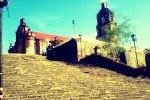
I am fortunate enough to be residing just 3 houses behind Paoay church -considered as the best example of earthquake baroque architecture. I have seen the four churches and each has its own unique characteristics. One of the better sides of visiting churches is that they have no entrance fees at all!
What makes Paoay church interesting is its rather unusual design. Prior to the Spanish era, the town of Paoay used to be called Bombay due to the presence of Indian traders near its coastal area. With the strong Hindu-Malay influences occurring within the town, oriental motifs were incorporated in the design of the church. This can be seen with the spirals on its buttresses, a highly Malay insignia. The best way to appreciate the structure is to see it from the corners of front lawn so as to see the 3D effect created by its imposing facade and wonderful rows of buttresses. Contrary to popular beliefs, Paoay church is not the oldest in the region - in fact, it is one of the youngest. It was built in 1704, while other nearby town-churches were built in the 1570s. Paoay church is made of coralstones and some bricks. The coralstones were harvested from the coastline of Pangil in the nearby town of Currimao (8Km away). Pangil boasts the longest stretch of "exposed" coral rock formations in the Philippines, ca. 2-3 km. long. Sunset photos here are superb! More photos at: https://www.facebook.com/media/set/?set=a.10150112670412613.282329.694602612&type=3
The Sta. Maria church sits on top of a fortified hill. I never got to appreciate this one before as I found it lacking in grace compared to the other 3 inscribed churches. But having paid closer attention to its details from my succeeding visits, I was convinced that this is truly a gem worth celebrating. It is the only baroque church in the Philippines that is isolated from the town plaza (back in those days, normally, the churches would dictate where a town center should be established), and the only access to the church is through a 85-step staircase made of granite slabs imported from China. Like Paoay Church, Sta. Maria is heavily supported by massive buttress along its sides. Sta. Maria is entirely made of bricks. More photos at: https://www.facebook.com/media/set/?set=a.10150533714237613.380811.694602612&type=3
San Agustin Church of Intramuros (Spanish: Ciudad Murada) is the oldest standing stone church in the Philippines. Unlike Paoay and Sta. Maria, San Agustin does not have external buttresses. The earthquake-proof system are its internal buttresses (that forms the side chapels inside) and vaults. The trompe l'oeil ceiling paintings were made by two Italian painters in 1875. Several conquistadores are also interred within the church. If given the opportunity to go inside the monastery and alleys, grab it - it is the church's best kept secrets. Notice as well the presence of Chinese fu dog statues on its facade. These were donated by the Chinese merchants who were in peaceful coexistence with the meztizos and Spaniards residing within the walled city. The church is largely made of volcanic tuff.
Maig-ao Church is a squatty church (similar to most Latin American churches) in the Visayan region. Due to the threats of Moro pirates in the Visayas, the church was made following the tradition of "fortress baroque" architecture. Miag-ao Church, together with Paoay and Sta. Maria does not boast a magnificently decorated interior. It prides, however, its facade - a real masterpiece of Filipino creativity. Notice how the towers are of unequal heights. The church is made using limestones and coralstones.
Comments
No comments yet.
